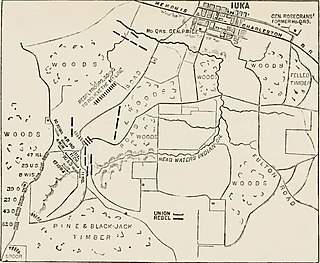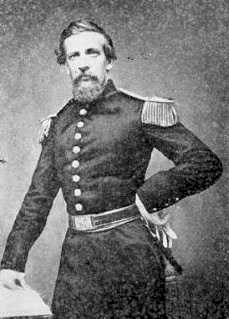
Earl Van Dorn was an American major-general who started his military career as a United States Army officer and became famous for successfully leading a defense of a Native American settlement from the Comanche. He joined Confederate forces in 1861 after the Civil War broke out and was a major general when he was killed in a private conflict. He is considered one of the greatest cavalry commanders to have ever lived.

Grenville Mellen Dodge was a Union Army officer on the frontier and a pioneering figure in military intelligence during the Civil War, who served as Ulysses S. Grant's intelligence chief in the Western Theater. He served in several notable assignments, including command of the XVI Corps during the Atlanta Campaign.

The Second Battle of Corinth was fought October 3–4, 1862, in Corinth, Mississippi. For the second time in the Iuka-Corinth Campaign, Union Maj. Gen. William Rosecrans defeated a Confederate army, this time one under Maj. Gen. Earl Van Dorn.

The Battle of Iuka was fought on September 19, 1862, in Iuka, Mississippi, during the American Civil War. In the opening battle of the Iuka-Corinth Campaign, Union Maj. Gen. William Rosecrans stopped the advance of the Confederate Army of the West commanded by Maj. Gen. Sterling Price.

The siege of Corinth was an American Civil War engagement lasting from April 29 to May 30, 1862, in Corinth, Mississippi. A collection of Union forces under the overall command of Major General Henry Halleck engaged in a month-long siege of the city, whose Confederate occupants were commanded by General P.G.T. Beauregard. The siege resulted in the capture of the town by Federal forces.

The Army of the West, also known as the Trans-Mississippi District, was a formation of the Confederate States Army during the American Civil War that was a part of the Army of Mississippi. It saw action in the Battle of Pea Ridge, Battle of Corinth, and Battle of Iuka and consisted of about 20,000 personnel.

The western theater of the American Civil War encompassed major military operations in the states of Alabama, Georgia, Florida, Mississippi, North Carolina, Kentucky, South Carolina and Tennessee, as well as Louisiana east of the Mississippi River. Operations on the coasts of these states, except for Mobile Bay, are considered part of the Lower Seaboard Theater. Most other operations east of the Appalachian Mountains are part of the eastern theater. Operations west of the Mississippi River took place in the trans-Mississippi theater.

John Stevens Bowen was a career United States Army officer who later became a general in the Confederate Army and a commander in the Western Theater of the American Civil War. He fought at the battles of Shiloh, Corinth, and the Vicksburg Campaign. He is often said to have died just as his abilities were gaining attention.

Theophilus Lyle Dickey was an Illinois jurist and military leader.
The following Union Army units and commanders fought in the Siege of Vicksburg of the American Civil War. The Confederate order of battle is listed separately. Order of battle compiled from the army organization during the campaign.
The 5th Ohio Cavalry Regiment was a regiment of Union cavalry raised in seven counties in southwestern Ohio for service during the American Civil War. It primarily served in the Western Theater in several major campaigns of the Army of the Tennessee.
The 8th Kentucky Infantry Regiment was an infantry regiment that served in the Confederate States Army during the American Civil War.

The Army of West Tennessee was a short-lived Confederate army led by Maj. Gen. Earl Van Dorn, which fought principally in the Second Battle of Corinth.
The 1st Arkansas Cavalry Battalion (Stirman's) (1864–1865) was a Confederate Army cavalry battalion during the American Civil War. The unit was also known as Brooks 1st Arkansas Cavalry Battalion, Stirman's, 1st Arkansas Cavalry Battalion, Stirman's Sharpshooter Regiment, 1st Regiment Arkansas Sharpshooters, and finally simply as Stirman's Arkansas Cavalry Regiment.
Charles Wesley Phifer was a Confederate States Army officer during the American Civil War who was unofficially appointed brigadier general.

The 9th Texas Cavalry Regiment was a unit of mounted volunteers that fought in the Confederate States Army during the American Civil War. The regiment fought at Round Mountain and Bird Creek (Chusto-Talasah) in 1861, Pea Ridge, Siege of Corinth, Second Corinth, Hatchie's Bridge and the Holly Springs Raid in 1862, and in the Atlanta campaign, Franklin, and Murfreesboro in 1864. The unit fought dismounted at Second Corinth and Hatchie's Bridge before being remounted as cavalry for the remainder of the war. The regiment surrendered to Federal forces on 4 May 1865 and its remaining personnel were paroled.

The 3rd Texas Cavalry Regiment or South Kansas-Texas Mounted Volunteers was a unit of mounted volunteers that fought in the Confederate States Army during the American Civil War. The regiment fought at Wilson's Creek and Chustenahlah in 1861, Pea Ridge, Corinth siege, Iuka, Second Corinth, and the Holly Springs Raid in 1862, Thompson's Station in 1863, and at Yazoo City, in the Atlanta campaign, and at Nashville in 1864. The regiment fought dismounted at Iuka and Second Corinth before being remounted for the rest of the war. The regiment surrendered to Federal forces in May 1865 and its remaining 207 men were paroled.

The 6th Texas Cavalry Regiment was a unit of mounted volunteers that fought in the Confederate States Army during the American Civil War. The regiment fought at Chustenahlah in 1861. The following year the unit fought at Pea Ridge, First Corinth, Second Corinth, Hatchie's Bridge, and Holly Springs. The 6th Texas Cavalry participated in the fighting at Thompson's Station in 1863, the Atlanta campaign, and the Franklin–Nashville Campaign in 1864. The regiment formally surrendered to Union forces in May 1865 and its remaining soldiers were paroled.

The Holly Springs Raid saw Earl Van Dorn lead Confederate cavalry against a Union supply depot at Holly Springs, Mississippi during the American Civil War. The mounted raiders achieved complete surprise, capturing the Federal garrison and destroying $1.5 million of supplies intended for Ulysses S. Grant's army. In the following days, Van Dorn's troopers moved north along the Mississippi Central Railroad almost to Bolivar, Tennessee, destroying track and bridges, before escaping into northern Mississippi. The damage inflicted by the Holly Springs Raid together with the harm caused by Nathan Bedford Forrest's West Tennessee Raids forced Grant's Union army to withdraw to Memphis. Additionally, both Van Dorn and Forrest's raids obstructed the full implementation of Grant's controversial General Order No. 11 for weeks, preventing many Jewish people from being expelled from Grant's military district.

Landis's Missouri Battery, also known as Landis's Company, Missouri Light Artillery, was an artillery battery that served in the Confederate States Army during the early stages of the American Civil War. The battery was formed when Captain John C. Landis recruited men from the Missouri State Guard in late 1861 and early 1862. The battery fielded two 12-pounder Napoleon field guns and two 24-pounder howitzers for much of its existence, and had a highest reported numerical strength of 62 men. After initially serving in the Trans-Mississippi Theater, where it may have fought in the Battle of Pea Ridge, the unit was transferred east of the Mississippi River. The battery saw limited action in 1862 at the Battle of Iuka and at the Second Battle of Corinth.















